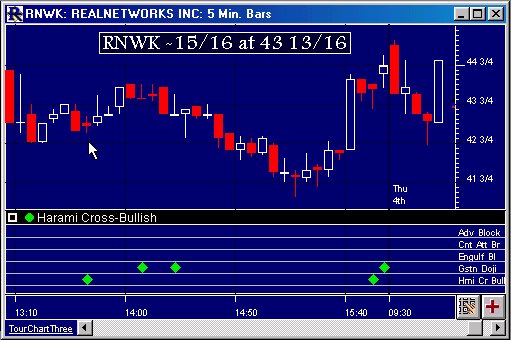The candlestick pattern recognition indicator tests for any of 41 candlestick patterns of interest. When adding the indicator to a chart, choose as many patterns as you like from the list of available patterns. Other parameters include three values used by the indicator to perform the pattern matching.
The "Equal Percent" value is used to specify how close two prices must be to one another to be considered "equal" for the purposes of pattern recognition. . Specify the value in percentage points, e.g. 1 means 1%, .5 means one half of 1%. If a candlestick closes within "Equal Percent" of it's open, then it is considered a Doji pattern. If a body is too long to be a Doji pattern, then it is considered either "Long" or "Small". It is "Long" if the body is larger than the average of all candle body lengths in the chart and "Small" if it is smaller.
The "Long Shadow" value is used to test whether a candlestick has a long shadow. The shadow of a candle, sometimes called "wick", is the portion of the candle that protrudes above or below the candle body. The long shadow value is multiplied by the actual body length and compared with the shadow length to determine if the shadow is "long". A value of 2, the default, means that a shadow must be twice a long as the candle body to be considered a long shadow.
Similarly, the "Small Shadow" value is used to determine whether a candle has a shadow smaller than the value times the real body length. A value of 1, the default, means that smaller shadows are those whose length is less that one body length. A value of .5 means that a shadow must less than half the size of the body to be considered small.
The candle pattern recognition indicator is display in its own sub window within a chart window. Each pattern name selected is represented by a horizontal line with diamonds marking the view period positions where a the pattern was recognized. It is advisable, but not necessary, that the chart of the instrument be displayed in candlestick format. The crosshair tool may be used to line up a diamond with the actual candle.
Pointing the mouse at an instrument's candle while holding the mouse button down causes the title bar of the candle pattern recognition sub window to show the names, if any, of any patterns recognized for that candle.
Below is a list of the candlestick patterns that are recognized.
- Abandoned Baby Top
- Advance Block
- Belt Hold - Bearish
- Belt Hold - Bullish
- Counter Attack-Bearish
- Counter Attack-Bullish
- Dark Cloud Cover
- Engulfing-Bearish
- Engulfing-Bullish
- Evening Doji Star
- Evening Star
- Falling Three Method
- Gravestone Doji
- Hammer
- Hanging Man
- Harami-Bullish
- Harami Cross-Bullish
- Harami -Bearish
- Harami Cross-Bearish
- High Wave
- In Neck
- Inverted Hammer
- Long Legged Doji
- Mat Hold
- Morning Doji Star
- Morning Star
- Piercing Line
- Rising Three
- Separating Line-Bearish
- Separating Line-Bullish
- Shooting Star
- Side by Side Wide Gap Down
- Side by Side Wide Gap Up
- Stalled
- Tasuki Downside Gap
- Tasuki Upside Gap
- Three Gaps Down
- Three Gaps Up
- Three Soldiers-Bullish
- Thrusting Line
- Upside Gap 2 Crows
Candlestick Characteristics
The following candlestick characteristics are used to to determine if patterns are present. Some patterns may only use one of these characteristics, while others may use several. Color Color is either White or Black. Color is considered White for up candles (CL > OP) and Black for down candles (CL < OP).
Shape
Shape is either Long, Small, or Doji. Shape is considered Long if the Body is larger than the average body size (of previous candles). Shape is considered Doji if the body is less than EP% of the lowest body price, where EP is the Equal Percent option available in the CPR preferences which defaults to 0.50 but can be customized by the user. In other words, it's Doji if:
ABS(CL - OP) < (EP/100) * MIN(CL, OP)
And the Shape is considered Small if the body is anywhere between Long and Doji. The Shape will always be one of the three (Long, Small, Doji).
Top Shadow
Top Shadow can be either Long, Small, or Medium. The Top Shadow may also be referred to as the Upper Wick. The Top Shadow is Long if it is greater than body multiplied by LS (the Long Shadow setting in the CPR prefs). The Top Shadow is Small if it is less than body multiplied by SS (the Small Shadow setting in the CPR prefs). The Top Shadow is considered Medium anywhere in between.
Bottom Shadow
Bottom Shadow can be either Long, Small, or Medium. The Bottom Shadow may also be referred to as the Lower Wick. The Bottom Shadow is Long if it is greater than body multiplied by LS (the Long Shadow setting in the CPR prefs). The Bottom Shadow is Small if it is less than body multiplied by SS (the Small Shadow setting in the CPR prefs). The Bottom Shadow is considered Medium anywhere in between.
Presentation

Above is a 5 Minute Candlestick Chart of Real Networks. The green diamonds in the lower window pane represent the existence of the corresponding candlestick pattern in the scale to the right. When the cursor is over a bar, any patterns recognized on that bar are displayed in the pane title bar for the candlestick patterns.


